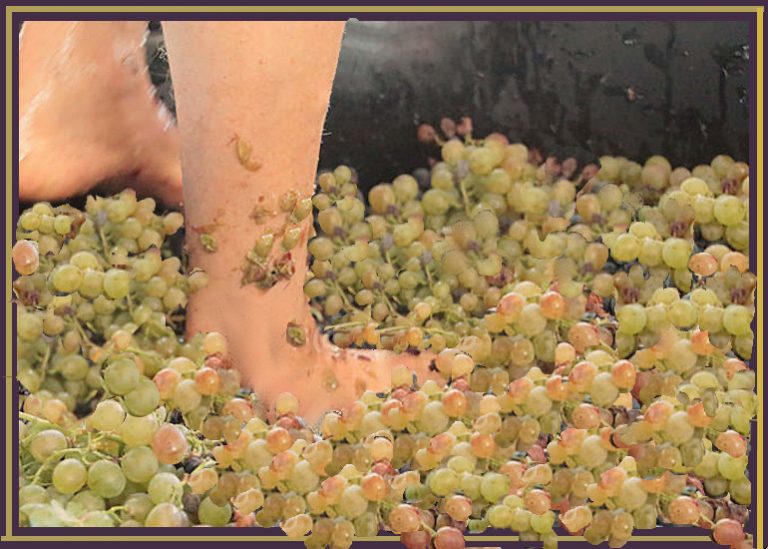70 kilograms of Sauvignon-Blanc grapes at a price of EUR 1.40 per kilo lie in front of me in half a wooden barrel. Their degree of oechsle (natural sugar content to determine the later alcohol percentage) reads 95, in fact a perfect value and the grapes taste deliciously aromatic (not as sour as Riesling). Specifically, this means 200 grams of sugar per kilogram / liter of juice, so nothing for a diet.
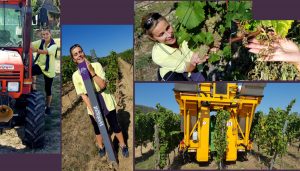
But step by step: After a long search I finally found a place at the “Four Seasons Winery” where you can still treat the wine with your feet. Just as the Romans did it centuries or even milennias ago. The oldest evidence of the existence of wine comes from today’s Georgia. Remains of clay jugs have been found there dating from around 6000 BC. and are decorated with grape reliefs.
So I finally arrive in Friedelsheim (not far from Bad Dürkheim / Palatinate) and I am welcomed by estate manager Walter B. and one of his cellar masters. Both still look a bit skeptical, but agree with me that this experience should definitely be made once in a lifetime.
My barrel is directly placed in front of the modern wine press and the other employees are fully occupied with one of the last pressings for this year. Several tubs and 10,000 liter barrels are stored everywhere. Before the Sauvignon-Blanc grapes, the Chardonnay was pressed, which you can currently buy as so-called „New Wine“ in the nearby shop.
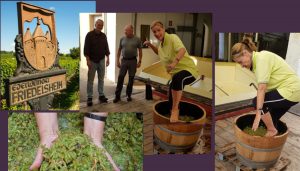
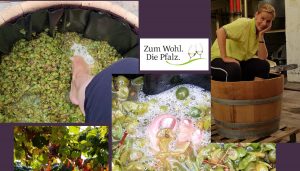
Here we go: the first touch of the grapes is very gentle and pleasant, because they were harvested by a full-harvester / vibrator largely without leaves and stems. The mass feels a bit like the muddy edge of a moor lake because you keep sinking in. To my surprise, despite the beautiful weather, the grapes are even colder than expected ( around 15 degrees Celsius). The harvesting is preferably done in the early morning so that the grapes stay cool enough to proof and control the fermentation process lying ahead.
While continuing with the leg movement, however, the feeling of coldness is somewhat reduced and after about three minutes the first small puddles of juice can be seen between the grapes. The stamping and marching causes more and mores splashes, the grapes become slippery and you have to be careful about your balance.
While no one in Germany nowadays presses grapes on foot for official production (depending on the quantity it would be very time-consuming and even small quantities would take 1-2 hours), this method is sometimes still common in Sardinia, Spain and Portugal. Particularly in case of exquisite port wine production, it should be very advantageous if the grape seeds are not damaged during pressing so that any bitter substances could penetrate.
As I keep on stepping and talking, I learn that despite the drought, an overall good harvest result with above-average quality can be expected. The problem is not so much the reduced amount as the fact that the vines do not absorb the typical soil minerals in full due to the lack of water, which can lead to a slightly change in taste.
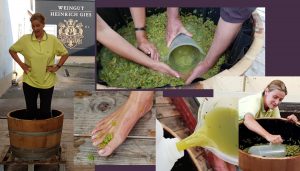
When I finally finish and get out, my feet feel very soft, as if you had applied a thick layer of “Hydra cream”. And of course you can even feel the high sugar content, because everything feels sticky up to calf level. Only sustainable cleaning with water and vigorous rubbing with a towel is of help.
Now of course the noble grape juice has to be filled into a transport container. Ideally, the barrel has an outlet tap at the bottom; but here the juice has to be skimmed off by hand. It takes a while, but it’s so wonderful to taste the juice again and again. Just delicious, what a flavor.
Incidentally, the entire fermentation process of the wine takes only ten days. Then the yeast settles on the bottom, stops its alcoholic fermentation and the actual maturation process in the barrel can begin. Such a light, fresh wine reaches its quality peak already after just 1-2 years. The only wine that can be sold in the same year after the harvest in July is the “Beaujolais Primeur” from the French wine-growing region of the same name near Lyon.
Well, usually nothing of the valuable biomass is vasted, because the remains of the grape peel, the so-called pomace, can be used to distill a wonderful grappa.
Incidentally, the term “keltern/pressing” comes from the Latin “calcare”. https://de.wikipedia.org/wiki/Kelter
What a morning. There was a lot of laughter and I was able to ask the two experts all of my questions on the subject of “wine production”. With five liters of fresh grape juice and a bottle of „New Wine“ (not yet clear) from the cooperative store, I make my way home again. Half of the liquid I intend to consume as grape juice, the rest I want to develop it into my own sparkling „New Wine“ . The remaining cider I left on site. However, this one will not be added to the official wine production, as this among other things, would not suit the EU hygiene rules.
A total of (just) 15 hectares of vineyards in Ungstein, Friedelsheim and Wachenheim are cultivated by the “Four Seasons Winemakers”. In addition to their White Wines, the traditional winery (153 years old) also has Red Wines such as Merlot, Pinot Noir, Cabernet and Dornfelder in its range. Small but fine, they are all stored in well-conditioned cellars and slumber towards their tasting and our pleasure/ culinary delight.

